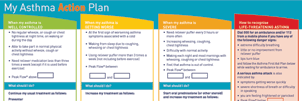Asthma Cycle of Care

Asthma Action Plans are part of the Cycle of Care initiative launched by the Commonwealth Government and is supported by the Asthma Foundations.
The Asthma Cycle of Care initiative has replaced the Asthma 3+ Visit Plan and is a direct response to feedback provided by respiratory physicians, GPs and patients and is based on the latest knowledge about how to treat asthma most effectively.
The Asthma Cycle of Care is a plan that encourages individuals with moderate to severe asthma to visit their GP at least two times in a 12 month period to discuss their asthma management. As a result these visits will:
- Document diagnosis and assessment of asthma severity and level of asthma control
- Review the patients use of, and access to, asthma related medication and devices
- Provide a written Asthma Action Plan (or alternative if the patient is unable to use a written action plan)
- Provide asthma self management education
- Review the written or documented Asthma Action Plan
By visiting your GP even when you are healthy, the Cycle of Care plan aims to ensure your asthma stays at is best and doesn't interfere with your life.
To find out more about the Asthma Cycle of Care visit the Asthma Cycle of Care website or download the Asthma Cycle of Care Fact Sheet.
What is an Asthma Action Plan?
| Download an Asthma Action Plan now |
An Asthma Action Plan is a written set of instructions prepared in partnership with your doctor to assist you to manage your asthma at different times. Your plan should help you to:
- Recognise worsening asthma symptoms
- Start treatment quickly
- Seek the right medical assistance
Early attention to worsening asthma may prevent you from having a serious attack. You can ask your doctor to write an Asthma Action Plan to suit your individual needs or use one of the many Asthma Action Plans available. There are even plans designed for remote indigenous communities.
Why have a written Asthma Action Plan?
An Asthma Action Plan allows you and your doctor to create an individual plan for you to manage your asthma. The Action Plan is a written reminder of that discussion and advises you about how to control you’re asthma and what to do when your asthma is worsening and you need help.
Asthma Action Plans have been shown to be one of the most effective asthma interventions available. A well-designed Asthma Action Plan can:
- Reduce absences from work or school
- Reduce hospital admissions
- Reduce emergency visits to general practice
- Reduce reliever medication use
- Improve lung function
How does an Asthma Action Plan work?
To help the person with asthma and/or their carer take early action to prevent or reduce the severity of an asthma attack, Asthma Action Plans may be based on symptoms and/or peak expiratory flow (PEF) measurements individualised according to the pattern of the person’s asthma.
Although different people need different Asthma Action Plans they all have the same essential features. Basic details include the date the plan was formulated, the patient’s name, and their doctor’s contact details. Contact details for the patient’s carer or emergency contact person can also be added.
Many plans follow a traffic light system for assessing the severity of exacerbations, moving from green for “under control” to red for “emergency”. The plans identify signs and symptoms that allow the patient and/or their carer to recognise severity of the attack and direct what action to take in response. Most plans will also include information about the doses and frequencies of regular medications taken to control the individual’s asthma.
It is important to identify the signs of worsening asthma and link them to steps you should take to help manage them and prevent further deterioration. Any deterioration responds best to rapid action.
Do children need an Asthma Action Plan?

An Asthma Action Plan is a vital tool for parents and carers in managing childhood asthma. Asthma Action Plans for children are based on the same structure as adult plans but with greater emphasis on symptoms. Once formulated, a good Action Plan will be a written reference to reinforce the advice given by the doctor and copies can be provided to schools, kindergartens, childcare centres, or to anyone caring for your child.
Regular review of the Asthma Action Plan is especially important in children as their level of asthma severity or control tends to change as they develop.
Peak expiratory flow (PEF) measurement
Using PEF measurements as a part of Asthma Action Plan is becoming increasingly common and it can be beneficial for people with more severe or difficult-to-control asthma. It can also be useful in those who are not readily aware of the symptoms of limited airflow such as the elderly.
When PEF is used in an Asthma Action Plan it should be based on personal best rather than on predicted values, and falls in PEF without symptoms should trigger a visit to your doctor rather than simply increasing the levels of medication as there is a risk of over-treatment.
PEF measurement is not recommended for children under 12 years where research shows a change in symptoms is as effective as PEF for indicating that asthma is getting worse.
For more information on PEF go to the Asthma Management Handbook 2006: Role of PEF monitoring.
A small number of people with asthma may benefit from long-term PEF monitoring. For more information and a PEF chart template go to Peak Flow Chart.
 |

